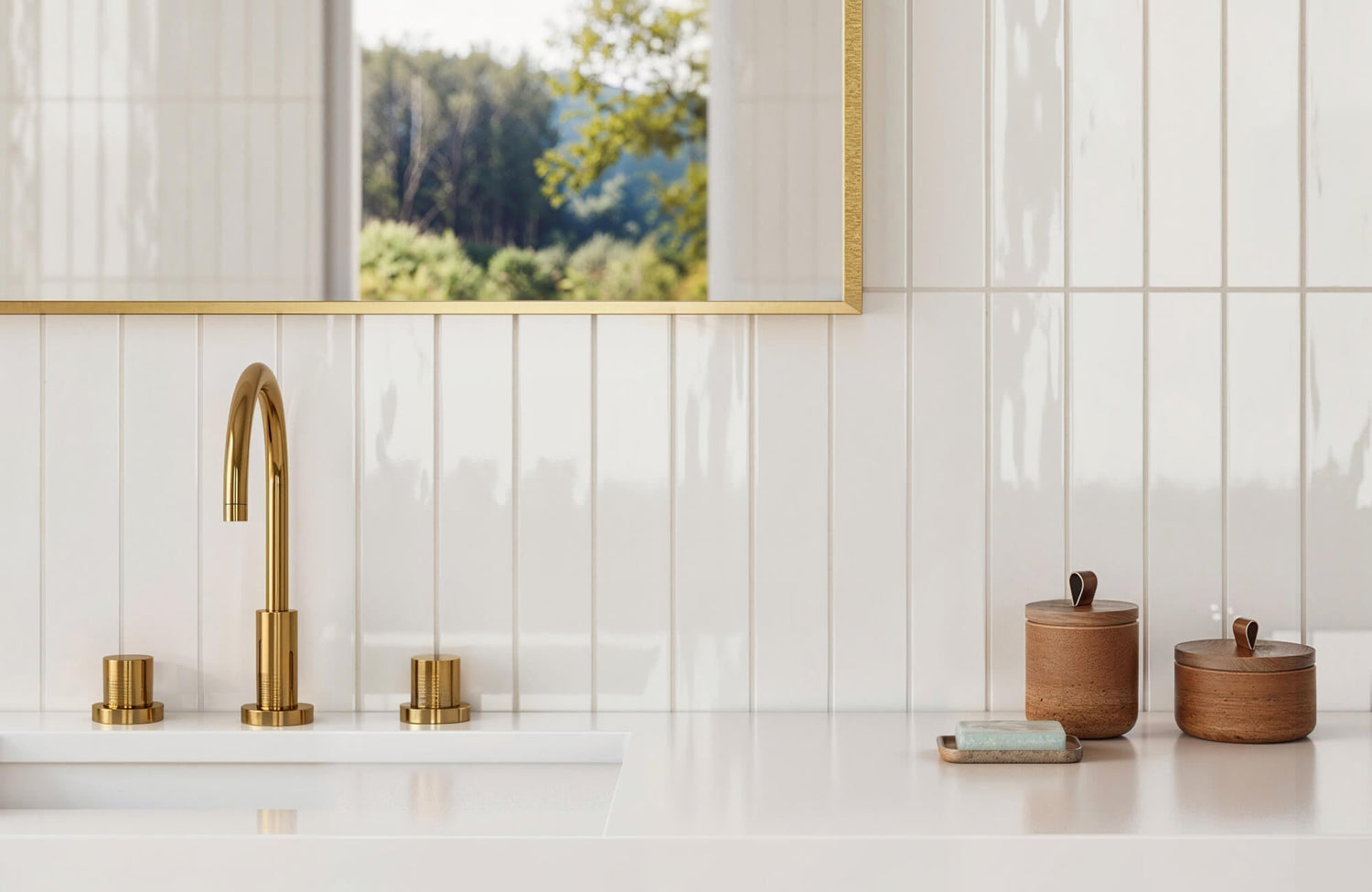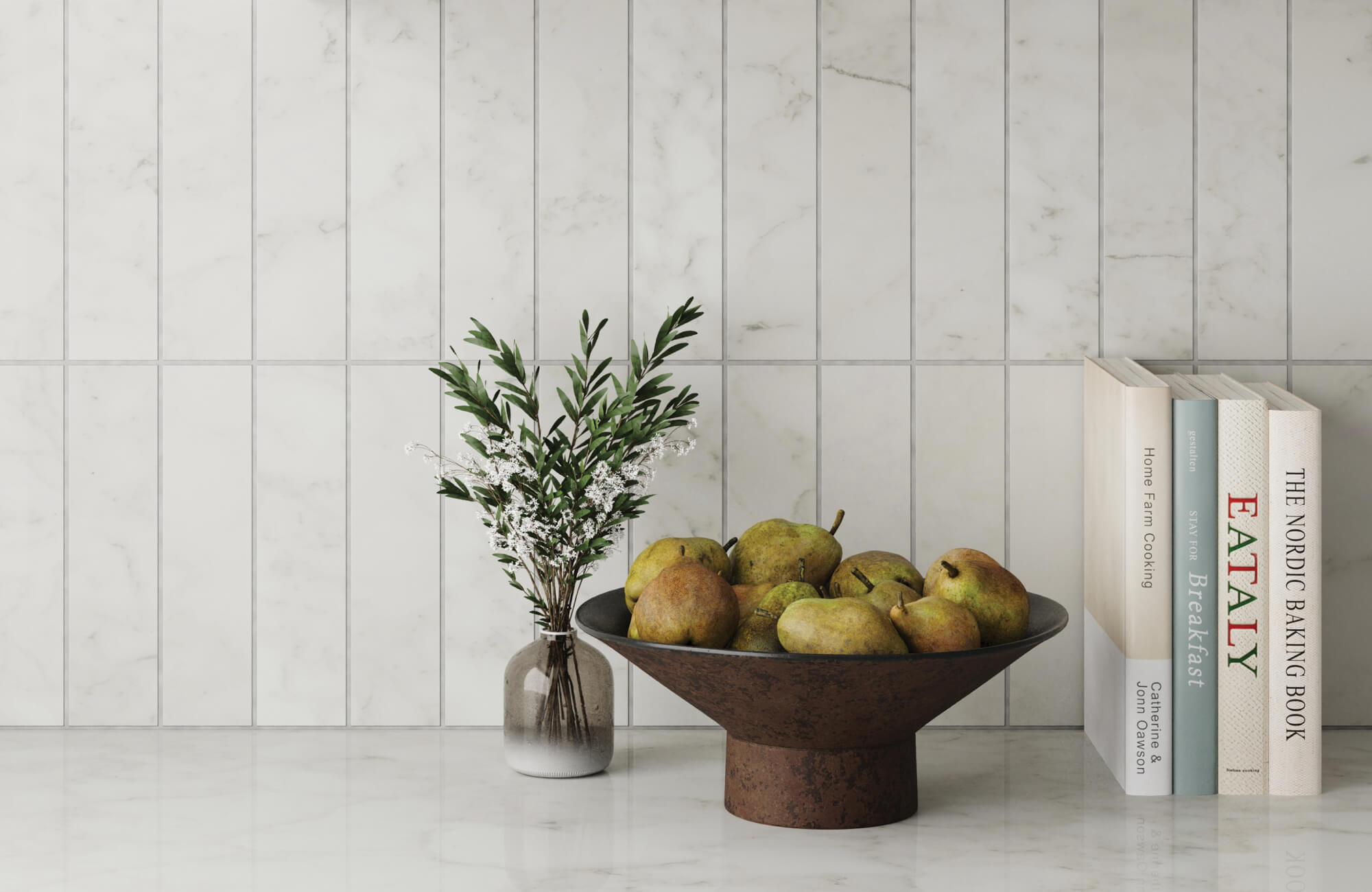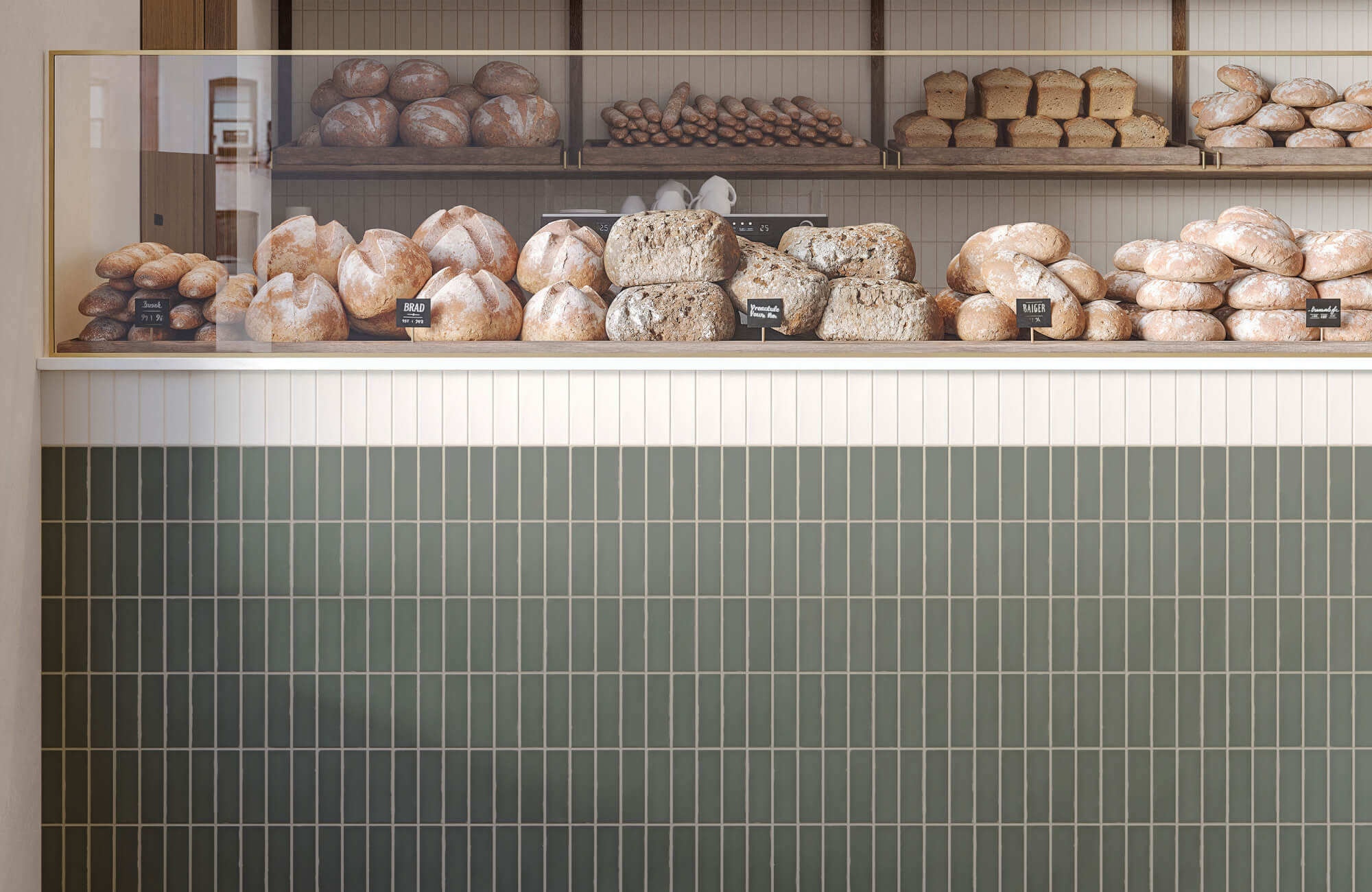Subway tile, once a hallmark of metropolitan infrastructure, now graces contemporary interiors with timeless sophistication. Characterized by its rectangular shape, most commonly 3" by 6", a flat glazed surface, and a clean, modular layout, a subway tile is both functional and visually enduring. Its clean lines, adaptability, and historical roots also make it a favorite among designers and homeowners alike.
This guide reimagines the classic appeal of subway tile, tracing its evolution from utilitarian design to a celebrated element in modern aesthetics. We’ll explore innovative size formats, bold color experiments, and expressive textures—arming you with inspiration and knowledge to bring this enduring style into your own space.
The Classic Subway Tile
First installed in New York’s underground transit system in 1904, subway tiles were designed with functionality, durability, and cleanliness in mind. The original tiles were made from white glazed ceramic, chosen for their light-reflecting properties and resistance to staining and microbial growth. Over time, what began as a purely practical solution has evolved into a visual language that communicates simplicity, order, and timeless charm. This transformation is a testament to the tile’s ability to blend classic aesthetics with modern-day relevance.
Key Characteristics
The classic subway tile owes its distinct identity to a few consistent, technically defined features. From proportional shape to surface treatment, each element contributes to both its visual appeal and functional resilience. Together, these characteristics ensure that subway tile remains a design staple across both residential and commercial settings. Understanding these features allows you to fully appreciate what makes this tile format so iconic.
Shape
The defining feature is its standard rectangular form with a 2:1 aspect ratio, conforming to the golden ratio principles of visual harmony. This ratio ensures that when tiles are installed in horizontal bands, they provide a balanced and rhythmic linear visual effect, commonly used in spatial modulation and perspective correction in design. The familiarity of this shape also lends a comforting sense of order to interiors. It’s a detail that subtly reinforces symmetry without feeling rigid.
Surface
Originally kiln-fired and glazed using a lead-based vitreous finish, today's tiles use lead-free enamels and UV-stabilized glazes. The gloss level ranges from high-gloss (>70 GU) to matte (<15 GU), which affects reflectivity and light diffusion in a space. The glaze provides a vitrified surface, improving chemical resistance (per ASTM C650) and surface hardness (Mohs scale of ~5–6). This finish not only protects the tile but also amplifies its visual impact.
Size
The prototypical size is 3"x6", offering a modular unit that allows for easy layout alignment, especially in running bond or herringbone formats. Modern formats include metric conversions and imperial derivatives, with calibrated edges (precise, machine-cut edges) or cushioned edges (slightly rounded, often found in traditional ceramics). These variations maintain the tile’s core proportions while introducing subtle options for customization. As a result, they offer flexibility without compromising the foundational appeal.
Pattern
The running bond or offset brick pattern offers lateral stability during installation, minimizing visible discrepancies in wall plane flatness. This layout provides aesthetic motion without overwhelming visual noise and is particularly effective in creating linear continuity in long, narrow spaces such as hallways or galley kitchens. It’s also a design strategy that brings structure without monotony. Over time, its versatility has proven both timeless and widely adaptable.
Material Options
Material selection greatly influences a tile's durability, water resistance, and aesthetic presence. Each option, from ceramic to natural stone, has unique technical properties suited for different environments. By choosing the appropriate material, you ensure both long-term performance and design compatibility. Here’s a closer look at what each option offers.
Ceramic
Made from red or white clay, ceramic tiles are fired at lower temperatures than porcelain (~1,000–1,200°C), which makes them slightly more porous (absorbing >3% water per ANSI A137.1 standards). They’re cost-effective, lightweight, and ideal for vertical applications where impact resistance isn’t paramount. Particularly well-suited for wall installations, ceramic tiles are commonly used for backsplashes, bathroom walls, and other dry to moderately wet locations. They also offer the widest range of finishes and styles, making it a practical choice that doesn’t compromise on design.
Porcelain
Composed of kaolin-rich clay and fired at higher temperatures (>1,200°C), porcelain tiles have a water absorption rate of <0.5%, qualifying them as impervious (per ANSI A137.1). This makes them ideal for showers, wet rooms, or exterior facades. Often available in rectified formats, they enable tight grout joints (<1/8”) for a seamless look. Their density and durability make them a preferred option in busy areas and especially well-suited for floor installations where moisture resistance and long-term wear are critical.
Natural Stone (Marble, Slate, Granite)
These materials are quarried, cut, and often honed or polished. Marble (calcite-based) offers veining and translucency but is acid-sensitive (reacts to vinegar or citrus). Slate and granite are silicate-based, offering higher Mohs hardness and resistance to etching. With proper sealing, these luxurious materials provide beauty and resilience, making them ideal for high-impact design statements.

Modern Interpretations of Subway Tile
In contemporary design, subway tile transcends its origins to become a vehicle for expression. Modern variations introduce bold proportions, experimental colors, tactile finishes, and inventive patterns that reflect current design philosophies, ranging from minimalism to maximalism, biophilic design to industrial chic. These reinterpretations maintain the tile’s heritage while opening the door to personal creativity. The result is a versatile material that speaks to a wide range of design languages.
Size Variations
Altering the size of subway tiles offers more than just visual variety—it influences how light interacts with a space and how tile patterns read across a surface. Different formats bring tailored advantages for different room scales and functions. Whether creating intricate detail with small tiles or a seamless effect with large ones, size becomes a powerful design lever. Understanding these dynamics allows you to choose confidently based on spatial and stylistic needs.
Smaller Formats (1" x 2", 2" x 4")
Used primarily for detailed applications, these tiles allow for high pixel-density layouts like mosaics or intricate borders. Smaller tiles introduce more grout lines, which can be color-matched or contrasted to create patterns and rhythm. Ideal for wet areas due to higher slip resistance from increased grout, they also provide a handcrafted, intimate feel. A perfect example, as shown in the photo above, is the Dani 1.6x5 Matte Ceramic Tile in Dove, which offers a refined, soft matte finish in a narrow format, perfect for backsplashes, bathroom niches, or spaces where subtle elegance and textural depth are desired.
Larger Formats (4" x 8", 6" x 24")
On the other hand, large-format tiles reduce grout lines, enhancing visual continuity and making surfaces easier to clean. They require a flatter substrate due to increased potential for lippage (edge height variation). These formats often use rectified porcelain to maintain edge consistency and are common in upscale, minimalist interiors. For example, Edward Martin’s Dax 6x24 Matte Porcelain Tile in Rust offers a striking elongated silhouette and rich, earthy tones, ideal for feature walls or open-concept floors where you want to blend bold character with seamless flow.
Color Exploration
Color selection is one of the most powerful tools in tile design. It sets the emotional tone, complements the broader palette, and even affects the perception of light and space. Choosing the right hue can transform a room from serene to vibrant, minimalist to bold. In modern interiors, subway tile takes on a fresh identity through the use of bold colors, deep neutrals, and tonal grout combinations—recasting a classic shape in a distinctly contemporary light.
Pattern Play
Patterns go beyond visual flair—they can enhance spatial flow, break up monotony, or create directional movement in a room. The right layout can subtly reinforce architectural lines or serve as a centerpiece. Pattern also plays a key role in how tiles interact with surrounding design elements. In modern interiors, unconventional layouts like vertical stacks, herringbone, or chevron reimagine the traditional subway tile format, transforming it into a statement of contemporary design.
Textural Experimentation
Beyond color and size, texture brings depth and tactile richness to subway tiles. Surface finishes can shift a room’s tone from sterile to cozy or sleek to rustic with remarkable impact. Texture also interacts with light differently than flat surfaces, adding dimension and nuance. In modern spaces, matte, brushed, or subtly uneven finishes reinterpret the classic subway tile with a contemporary edge, bringing softness, sophistication, and tactile interest to streamlined interiors.

Subway Tile in Different Rooms
Subway tile may be universally recognizable, but how it's used varies greatly from room to room. Each space in a home imposes unique demands, influencing the choice of tile material, finish, and layout for optimal performance and visual appeal. By tailoring selections to the needs of each environment, you ensure that both form and function are honored.
Kitchen Applications
The kitchen is the most common setting for subway tile, particularly as a backsplash. Glazed ceramic or porcelain is ideal here due to its resistance to food splatter, heat, and moisture. A 3" x 6" tile in a running bond pattern provides timeless elegance, while larger formats or stacked patterns suit contemporary cabinetry and open shelving. To enhance practicality without sacrificing style, contrast grout can be especially useful, helping to disguise everyday cooking stains while adding visual definition.
Bathroom and Wet Rooms
Subway tile is an ideal choice for high-moisture environments such as showers and bathrooms, where durability and ease of maintenance are essential. Among the available materials, porcelain stands out for its low porosity and excellent resistance to mold, making it particularly well-suited for wet zones like shower walls and floors. Meanwhile, ceramic tiles are better suited for vertical applications; their lighter composition and extensive variety of colors, finishes, and formats make them perfect for adding style and softness to bathroom walls, vanities, and feature areas.
A great example is the Ellie 2.5x8 Matte Ceramic Tile in Moss, as displayed in the picture above. It combines a soothing, nature-inspired green hue with a matte finish, introducing a gentle, earthy elegance that softens the space without overpowering it. The subtle green color, when paired with the classic subway form, enhances the atmosphere of tranquility and cleanliness, transforming everyday routines into a serene, spa-like experience.
Entryways and Mudrooms
Subway tile in mudrooms and entryways serves a functional role, standing up to daily wear, tracked-in dirt, and exposure to moisture. For added safety and warmth, textured porcelain or honed stone tiles are ideal choices, offering both slip resistance and a grounded aesthetic. Similarly, earthy tones in basketweave or offset patterns create a rustic, welcoming atmosphere, especially when paired with wooden benches or shaker-style cabinetry. Together, these design elements combine durability with charm, making a stylish and resilient first impression.
Living Areas and Fireplaces
While less conventional, incorporating subway tile in living rooms and around fireplaces can introduce unexpected contrast and character. Heat-resistant stone or porcelain tiles are excellent for framing a hearth, providing both durability and a refined visual anchor. For added depth and texture, beveled or handmade tiles create subtle shadow play under ambient lighting, enhancing the room's overall atmosphere. If you're aiming for a bold, design-forward look, matte black or deep green tiles paired with white grout evoke a striking, modern Art Deco aesthetic.
To make your decision even easier, Edward Martin offers an Augmented Reality (AR) tool that allows you to visualize tile options directly in your space. With just a few taps, you can explore how different subway tile styles, colors, and finishes will look alongside your existing surfaces, lighting, and design elements. It’s an invaluable step that brings clarity and confidence to the selection process, helping you turn inspiration into a perfectly tailored result.

Choosing the Right Subway Tile
With the market offering thousands of variations, informed selection of subway tile involves a clear understanding of your architectural constraints, environmental conditions, and design goals. Each decision, color, size, material, and pattern should harmonize form and function. Consider not just aesthetic appeal, but also how each option supports the unique needs of your space. These guiding factors will help you make confident and purposeful tile choices.
Overall Design Style
Subway tile adapts seamlessly to a wide range of interior design styles, from traditional kitchens to ultramodern bathrooms. For classic or vintage aesthetics, glossy white ceramic in a running bond pattern provides timeless charm. Contemporary or minimalist designs, on the other hand, benefit from large-format matte tiles or vertical stacking patterns that enhance geometric precision.
A perfect example is the Natasha 2x6 Glossy Porcelain Tile in Oat, which, as displayed in the kitchen above, beautifully complements warm wood cabinetry and brass accents, offering a soft, reflective finish that enhances light while maintaining an understated, organic elegance. Its neutral oat tone bridges the gap between traditional and modern aesthetics, creating a harmonious backdrop for mixed-material spaces. The slim 2x6 format also adds a handcrafted touch that subtly elevates the overall composition without overpowering other elements.
Color Scheme of the Surrounding Space
The color of your subway tile should interact thoughtfully with your room's palette, either complementing or contrasting it. For instance, light-colored tiles can help brighten dark cabinetry or confined spaces by reflecting more ambient light. Conversely, darker tiles offer depth and drama, especially when balanced with lighter countertops or fixtures. Consider undertones and lighting conditions to maintain color harmony across surfaces.
Room Size and Lighting Conditions
Tile size and finish significantly affect how space and light are perceived in a room. In small or dimly lit spaces, smaller glossy tiles can enhance light reflection and make the room feel larger. Conversely, large-format matte tiles can ground a bright, expansive room while reducing visual clutter. Always evaluate both natural and artificial lighting when selecting your tile to ensure consistent visual balance.
Desired Level of Visual Interest
The layout and finish of your subway tile dictate how much visual texture and movement it adds to a room. If your space already features bold patterns or complex materials, a subtle tile layout like stacked bond or tone-on-tone color will maintain balance. Simpler interiors can also benefit from striking patterns like herringbone or chevron to add architectural flair. The goal is to either complement or gently disrupt your space’s visual rhythm without overwhelming it.
Budget and Maintenance Requirements
When selecting subway tile, it's important to balance your design vision with practical considerations like cost, durability, and ongoing maintenance. Ceramic tiles are typically the most budget-friendly option and require minimal upkeep, making them an excellent choice for light-use or decorative areas. For spaces that demand more resilience, porcelain ceramic tiles provide superior durability and water resistance, though they come with higher upfront costs and more involved care.

Installation and Maintenance of Subway Tiles
Correct installation and maintenance are essential for preserving both aesthetic appeal and structural integrity. Subway tile may appear simple to install, but details matter, from substrate prep to grout selection and curing time. While DIY approaches are possible, it is often best to have professional installation, especially for intricate layouts or high-moisture areas, to ensure precise alignment, long-term durability, and a truly polished finish.
Installation Tips
Proper tile installation begins with thorough surface preparation and choosing the correct adhesive system based on substrate type and tile material. A level, moisture-resistant backer board is essential in wet areas, and tile spacers ensure consistent joint widths. For complex patterns like herringbone or basketweave, professional installation may yield the most precise and durable results. Don’t forget to use expansion joints and flexible grout in areas prone to movement or thermal variation.
Maintenance and Cleaning
Keeping subway tile looking pristine involves regular cleaning with non-abrasive, pH-neutral solutions appropriate to the tile’s finish. Glossy and porcelain tiles are easier to maintain, while natural stone and textured finishes may require sealing and specialized cleaners. Avoid acidic products on marble or soft glazes, as they can cause etching or discoloration over time. Establishing a monthly or quarterly cleaning schedule and inspecting grout for deterioration will also help extend the life and beauty of your tile installation.
Why Subway Tile Remains a Design Essential
Subway tile offers enduring versatility, balancing utilitarian strength with aesthetic adaptability. Whether installing classic white ceramic in a heritage home or experimenting with oversized, textured porcelain in a modern loft, subway tile empowers you to define spatial character with precision and style. Through technical insight and creative exploration, you can leverage this timeless element to elevate any interior space. No matter the room, purpose, or budget, the right subway tile can make a lasting design statement.
For personalized guidance in choosing the perfect subway tile for your space, Edward Martin also offers professional design consultations. Whether you need help coordinating colors, selecting patterns, or refining the overall aesthetic, our design experts work with you to bring your vision to life with confidence and creativity. It’s a helpful step that ensures your final choice isn’t just beautiful, but also thoughtfully tailored to your unique space.








